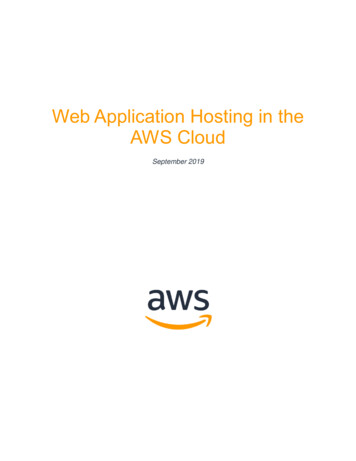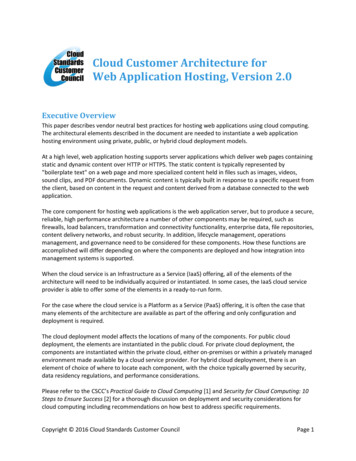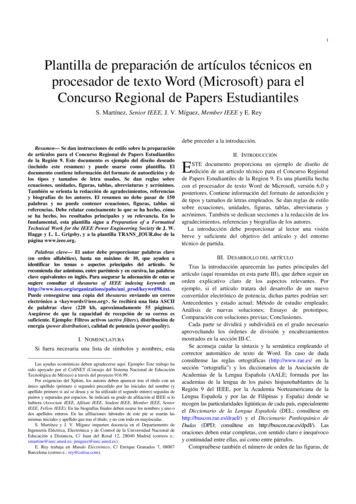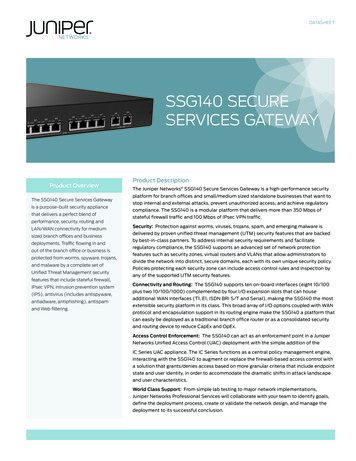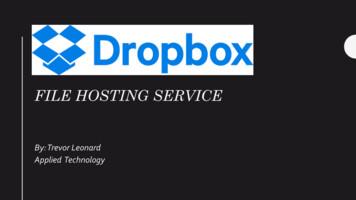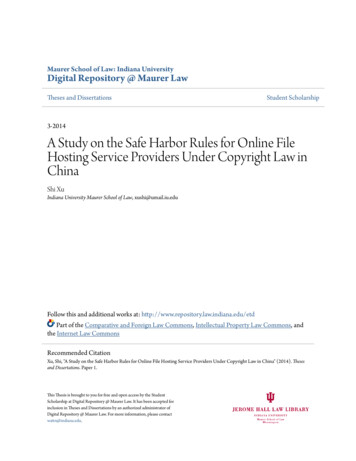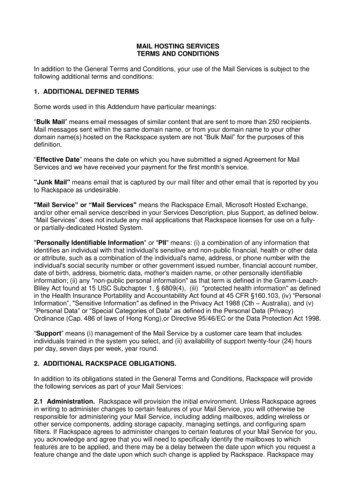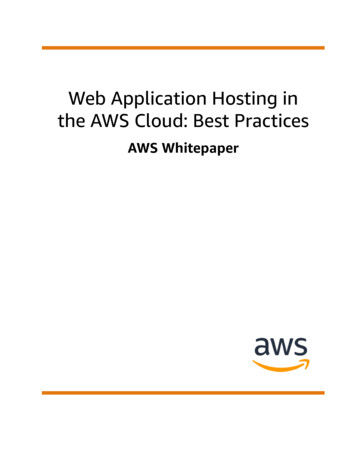
Transcription
Web Application Hosting inthe AWS Cloud: Best PracticesAWS Whitepaper
Web Application Hosting in the AWSCloud: Best Practices AWS WhitepaperWeb Application Hosting in the AWS Cloud: Best Practices: AWSWhitepaperCopyright Amazon Web Services, Inc. and/or its affiliates. All rights reserved.Amazon's trademarks and trade dress may not be used in connection with any product or service that is notAmazon's, in any manner that is likely to cause confusion among customers, or in any manner that disparages ordiscredits Amazon. All other trademarks not owned by Amazon are the property of their respective owners, who mayor may not be affiliated with, connected to, or sponsored by Amazon.
Web Application Hosting in the AWSCloud: Best Practices AWS WhitepaperTable of ContentsAbstract . 1Abstract . 1An Overview of Traditional Web Hosting . 2Web Application Hosting in the Cloud Using AWS . 3How AWS Can Solve Common Web Application Hosting Issues . 3A Cost-Effective Alternative to Oversized Fleets Needed to Handle Peaks . 3A Scalable Solution to Handling Unexpected Traffic Peaks . 4An On-Demand Solution for Test, Load, Beta, and Preproduction Environments . 4An AWS Cloud Architecture for Web Hosting . 4Key Components of an AWS Web Hosting Architecture . 5Network Management . 5Content Delivery . 6Managing Public DNS . 6Host Security . 6Load Balancing Across Clusters . 7Finding Other Hosts and Services . 7Caching within the Web Application . 8Database Configuration, Backup, and Failover . 8Storage and Backup of Data and Assets . 9Automatically Scaling the Fleet . 10Additional Security Features . 10Failover with AWS . 11Key Considerations When Using AWS for Web Hosting . 12No More Physical Network Appliances . 12Firewalls Everywhere . 12Consider the Availability of Multiple Data Centers . 12Treat Hosts as Ephemeral and Dynamic . 13Consider a Serverless Architecture . 13Conclusion . 14Contributors . 15Further Reading . 16Document Revisions . 17Notices . 18iii
Web Application Hosting in the AWSCloud: Best Practices AWS WhitepaperAbstractWeb Application Hosting in the AWSCloud: Best PracticesPublication date: September 2019 (Document Revisions (p. 17))AbstractHighly available and scalable web hosting can be a complex and expensive proposition. Traditionalscalable web architectures have not only needed to implement complex solutions to ensure highlevels of reliability, but they have also required an accurate forecast of traffic to provide a high level ofcustomer service. Dense peak traffic periods and wild swings in traffic patterns result in low utilizationrates of expensive hardware. This yields high operating costs to maintain idle hardware, and aninefficient use of capital for underused hardware.Amazon Web Services (AWS) provides a reliable, scalable, secure, and highly performing infrastructurefor the most demanding web applications. This infrastructure matches IT costs with customer trafficpatterns in real time.This whitepaper is for IT managers and system architects who look to the cloud to help them achieve thescalability to meet their on-demand computing needs.1
Web Application Hosting in the AWSCloud: Best Practices AWS WhitepaperAn Overview of Traditional WebHostingScalable web hosting is a well-known problem space. Figure 1 depicts a traditional web hostingarchitecture that implements a common three-tier web application model. In this model, the architectureis separated into presentation, application, and persistence layers. Scalability is provided by adding hostsat these layers. The architecture also has built-in performance, failover, and availability features. Thetraditional web hosting architecture is easily ported to the AWS Cloud with only a few modifications.Figure 1. A traditional web hosting architectureIn the following sections, we look at why and how such an architecture should be and could be deployedin the AWS Cloud.2
Web Application Hosting in the AWSCloud: Best Practices AWS WhitepaperHow AWS Can Solve CommonWeb Application Hosting IssuesWeb Application Hosting in theCloud Using AWSThe first question that you should ask concerns the value of moving a classic web application hostingsolution into the AWS Cloud. If you decide that the cloud is right for you, you’ll need a suitablearchitecture. This section helps you evaluate an AWS Cloud solution. It compares deploying your webapplication in the cloud to an on-premises deployment, presents an AWS Cloud architecture for hostingyour application, and discusses the key components of this solution.How AWS Can Solve Common Web ApplicationHosting IssuesIf you’re responsible for running a web application, you face a variety of infrastructure and architecturalissues for which AWS can provide seamless and cost-effective solutions. The following are just some ofthe benefits of using AWS over a traditional hosting model.Topics A Cost-Effective Alternative to Oversized Fleets Needed to Handle Peaks (p. 3) A Scalable Solution to Handling Unexpected Traffic Peaks (p. 4) An On-Demand Solution for Test, Load, Beta, and Preproduction Environments (p. 4)A Cost-Effective Alternative to Oversized FleetsNeeded to Handle PeaksIn the traditional hosting model, you have to provision servers to handle peak capacity. Unusedcycles are wasted outside of peak periods. Web applications hosted by AWS can leverage on-demandprovisioning of additional servers, so you can constantly adjust capacity and costs to actual trafficpatterns.For example, the following graph shows a web application with a usage peak from 9AM to 3PM andless usage for the remainder of the day. An automatic scaling approach based on actual traffic trends,which provisions resources only when needed, would result in less wasted capacity and a greater than 50percent reduction in cost.Figure 2. An example of wasted capacity in a classic hosting model3
Web Application Hosting in the AWSCloud: Best Practices AWS WhitepaperA Scalable Solution to Handling Unexpected Traffic PeaksA Scalable Solution to Handling Unexpected TrafficPeaksAn even more dire consequence of the slow provisioning associated with a traditional hosting modelis the inability to respond in time to unexpected traffic spikes. There are many stories about webapplications going down because of an unexpected spike in traffic after the site is mentioned in thepopular media. The same on-demand capability that helps web applications scale to match regulartraffic spikes can also handle an unexpected load. New hosts can be launched and ready in a matter ofminutes, and they can be taken offline just as quickly when traffic returns to normal.An On-Demand Solution for Test, Load, Beta, andPreproduction EnvironmentsThe hardware costs of building out a traditional hosting environment for a production web applicationdon’t stop with the production fleet. Quite often, you need to create preproduction, beta, and testingfleets to ensure the quality of the web application at each stage of the development lifecycle. While youcan make various optimizations to ensure the highest possible use of this testing hardware, these parallelfleets are not always used optimally: a lot of expensive hardware sits unused for long periods of time.In the AWS Cloud, you can provision testing fleets as you need them. Additionally, you can simulateuser traffic on the AWS Cloud during load testing. You can also use these parallel fleets as a stagingenvironment for a new production release. This enables quick switchover from current production to anew application version with little or no service outages.An AWS Cloud Architecture for Web HostingThe following figure provides another look at that classic web application architecture and how it canleverage the AWS Cloud computing infrastructure.4
Web Application Hosting in the AWSCloud: Best Practices AWS WhitepaperKey Components of an AWS Web Hosting ArchitectureFigure 3. An example of a web hosting architecture on AWS1. Load Balancing with Elastic Load Balancing (ELB)/Application Load Balancer (ALB) – Allows you tospread load across multiple Availability Zones and Amazon EC2 Auto Scaling groups for redundancyand decoupling of services.2. Firewalls with Security Groups –Moves security to the instance to provide a stateful, host-levelfirewall for both web and application servers.3. Caching with Amazon ElastiCache – Provides caching services with Redis or Memcached to removeload from the app and database, and lower latency for frequent requests.4. Managed Database with Amazon RDS – Creates a highly available, Multi-AZ database architecturewith six possible DB engines.5. DNS Services with Amazon Route 53 – Provides DNS services to simplify domain management.6. Edge Caching with Amazon CloudFront – Edge caches high-volume content to decrease the latencyto customers.7. Edge Security for Amazon CloudFront with AWS WAF – Filters malicious traffic, including XSS andSQL injection via customer-defined rules.8. DDoS Protection with AWS Shield – Safeguards your infrastructure against the most commonnetwork and transport layer DDoS attacks automatically.9. Static Storage and Backups with Amazon S3 – Enables simple HTTP-based object storage forbackups and static assets like images and video.Key Components of an AWS Web HostingArchitectureThe following sections outline some of the key components of a web hosting architecture deployed inthe AWS Cloud, and explain how they differ from a traditional web hosting architecture.Topics Network Management (p. 5) Content Delivery (p. 6) Managing Public DNS (p. 6) Host Security (p. 6) Load Balancing Across Clusters (p. 7) Finding Other Hosts and Services (p. 7) Caching within the Web Application (p. 8) Database Configuration, Backup, and Failover (p. 8) Storage and Backup of Data and Assets (p. 9) Automatically Scaling the Fleet (p. 10) Additional Security Features (p. 10) Failover with AWS (p. 11)Network ManagementIn a cloud environment such as AWS, the ability to segment your network from that of other customersenables a more secure and scalable architecture. While security groups provide host-level security (seethe Host Security (p. 6) section), Amazon Virtual Private Cloud (Amazon VPC) allows you to launchresources in a logically isolated and virtual network that you define.5
Web Application Hosting in the AWSCloud: Best Practices AWS WhitepaperContent DeliveryAmazon VPC is a free service that gives you full control over the details of your networking setup in AWS.Examples of this control include creating public-facing subnets for web servers, and private subnetswith no internet access for your databases. Additionally, Amazon VPC enables you to create hybridarchitectures by using hardware virtual private networks (VPNs), and use the AWS Cloud as an extensionof your own data center.Amazon VPC also includes IPv6 support in addition to traditional IPv4 support for your network.Content DeliveryEdge caching is still relevant in the AWS Cloud computing infrastructure. Any existing solutions in yourweb application infrastructure should work just fine in the AWS Cloud. One additional option, however, isto use Amazon CloudFront for edge caching your website.You can use CloudFront to deliver your website, including dynamic, static, and streaming contentusing a global network of edge locations. CloudFront automatically routes requests for your contentto the nearest edge location, so content is delivered with the best possible performance. CloudFrontis optimized to work with other AWS services, like Amazon Simple Storage Service (Amazon S3) andAmazon Elastic Compute Cloud (Amazon EC2). CloudFront also works seamlessly with any origin serverthat is not an AWS origin server, which stores the original, definitive versions of your files.Like other AWS services, there are no contracts or monthly commitments for using CloudFront – you payonly for as much or as little content as you actually deliver through the service.Managing Public DNSMoving a web application to the AWS Cloud requires some DNS changes to take advantage of themultiple Availability Zones that AWS provides. To help you manage DNS routing, AWS providesAmazon Route 53, a highly available and scalable DNS web service. Amazon Route 53 automaticallyroutes queries for your domain to the nearest DNS server. As a result, queries are answered with thebest possible performance. Amazon Route 53 resolves requests for your domain name (for example,www.example.com) to your Classic Load Balancer, as well as your zone apex record (example.com).Host SecurityUnlike a traditional web hosting model, inbound network traffic filtering should not be confined to theedge; it should also be applied at the host level. Amazon EC2 provides a feature named security groups.A security group is analogous to an inbound network firewall, for which you can specify the protocols,ports, and source IP ranges that are allowed to reach your EC2 instances. You can assign one or moresecurity groups to each EC2 instance. Each security group routes the appropriate traffic to each instance.Security groups can be configured so that only specific subnets or IP addresses have access to an EC2instance. Or they can reference other security groups to limit access to EC2 instances that are in specificgroups.6
Web Application Hosting in the AWSCloud: Best Practices AWS WhitepaperLoad Balancing Across ClustersFigure 4. Security groups in a web applicationIn the example AWS web hosting architecture in Figure 4, the security group for the web server clustermight allow access for any host only over TCP on ports 80 and 443 (HTTP and HTTPS), and frominstances in the application server security group on port 22 (SSH) for direct host management. Theapplication server security group, on the other hand, might allow access from the web server securitygroup for handling web requests and from your organization’s subnet over TCP on port 22 (SSH) fordirect host management. In this model, your support engineers could log in directly to the applicationservers from the corporate network and then access the other clusters from the application server boxes.For a deeper discussion on security, see the AWS Security Center. The center contains security bulletins,certification information, and security whitepapers that explain the security capabilities of AWS.Load Balancing Across ClustersHardware load balancers are a common network appliance used in traditional web applicationarchitectures. AWS provides this capability through the Elastic Load Balancing (ELB) service. ELB is aconfigurable load-balancing solution that supports health checks on hosts, distribution of traffic toEC2 instances across multiple Availability Zones, and dynamic addition and removal of Amazon EC2hosts from the load-balancing rotation. ELB can also dynamically grow and shrink the load-balancingcapacity to adjust to traffic demands, while providing a predictable entry point by using a persistentCNAME. ELB also supports sticky sessions to address more advanced routing needs. If your applicationrequires more advanced load-balancing capabilities you can run a software load-balancing package (e.g.,Zeus, HAProxy, or NGINX Plus) on EC2 instances. You can then assign Elastic IP addresses to those loadbalancing EC2 instances to minimize DNS changes.Elastic IP addresses are static IP addresses designed for dynamic cloud computing, that you can movefrom one instance to another.Finding Other Hosts and ServicesIn the traditional web hosting architecture, most of your hosts have static IP addresses. In the cloud,most of your hosts will have dynamic IP addresses. Although every EC2 instance can have both public7
Web Application Hosting in the AWSCloud: Best Practices AWS WhitepaperCaching within the Web Applicationand private DNS entries and will be addressable over the internet, the DNS entries and the IP addressesare assigned dynamically when you launch the instance. They cannot be manually assigned. Static IPaddresses (Elastic IP addresses in AWS terminology) can be assigned to running instances after theyare launched. You should use Elastic IP addresses for instances and services that require consistentendpoints, such as master databases, central file servers, and EC2-hosted load balancers.Server roles that can easily scale out and in, such as web servers, should be made discoverable attheir dynamic endpoints by registering their IP address with a central repository. Because most webapplication architectures have a database server that is always on, the database server is a commonrepository for discovery information. For situations where consistent addressing is needed, instances canbe allocated Elastic IP addresses from a pool of addresses by a bootstrapping script when the instance islaunched.Using this model, newly added hosts can request the list of necessary endpoints for communicationsfrom the database as part of a bootstrapping phase. The location of the database can be provided asuser data th
load from the app and database, and lower latency for frequent requests. 4. Managed Database with Amazon RDS – Creates a highly available, Multi-AZ database architecture with six possible DB engines. 5. DNS Services with Amazon Route 53
